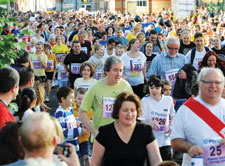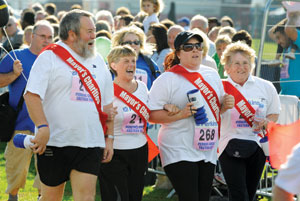So you want to start running?


In this issue of The Moment, and with the Perkins Great Eastern Run just around the corner, we’re taking a look at how to get started in running. We want to help encourage all of you to put on your trainers and get up and running – and maybe even give the city’s half marathon a go
If you’re already a runner, then you’re bound to know someone who wants to take it up too. Perhaps your partner secretly wants to run but doesn’t know how to get started? Or a friend or colleague is in awe of your running achievements?
 Our belief here at ‘The Moment’ is that pretty much anyone can be a runner. If you’re healthy and you can walk, then you can run. And it doesn’t matter how fast either, the point is that you’re out there doing it and improving your health into the bargain. The relentless running boom in the UK is testament to the number of people taking to the sport in their droves and for hugely different, but all very important reasons.
Our belief here at ‘The Moment’ is that pretty much anyone can be a runner. If you’re healthy and you can walk, then you can run. And it doesn’t matter how fast either, the point is that you’re out there doing it and improving your health into the bargain. The relentless running boom in the UK is testament to the number of people taking to the sport in their droves and for hugely different, but all very important reasons.
Why Run?
Well for one thing, if you’re trying to lose weight, running burns more calories than almost any other activity. At approximately 100kcal per mile (regardless of how fast you run) it beats other sports like cycling or swimming hands down in the fat burning stakes.
Running is also super time-efficient and fits in perfectly if you have a busy lifestyle. You can run for half an hour, shower and be ready for work in less time that it could take to drive to the gym. You can pretty much run anywhere, on-road or off, indoors or out, in summer or winter, alone, with friends or even your dog. It costs very little and the only ‘equipment’ you really need is a good pair of running shoes and if female, a supportive bra.
And if that’s not enough, running helps to beat depression and stress, lowers cholesterol, blood pressure and releases feel good endorphins, giving you that elusive ‘runners high’. But despite knowing all of that, sometimes just taking those first few steps can be daunting and is easy to put off. But as the Chinese proverb goes, ‘the journey of a thousand miles must begin with a single step’. So read on and get ready to become a runner.
The first steps
As Samuel Levensen once said ‘you can’t start at the top’. The classic mistake that many beginners make, is simply trying to run too fast when they first head out of the door. This is usually the pace that’s programmed into your brain from the last time you did any running – and that’s likely to be from your fitter and younger days, possibly even as far back as school. Gasping for breath before you’re even at the end of your street can be really demoralising, so getting that initial pace right can be make-or-break for whether you ever want to go running again. Your main goal at this stage is to increase the length of time you can run for – slowly and gradually over time. The key to doing this successfully is to slow your pace right down, factor in plenty of walk breaks and be patient.
You need to associate running with ‘pleasure’ not discomfort. Take the pace down to a comfortable level and always finish a session feeling like you could have done more. That way you’ll want to keep doing it and your brain won’t associate running with something unpleasant and painful.
First things first
Get checked out by your GP before you start, especially if you have a family history of heart disease, high blood pressure or have any concerns about your health and suitability to take up running. Any niggling pain or discomfort anywhere in your knees, hips, ankles or low back should be checked out by a physiotherapist before you start running. Many injuries develop over time and result from an old problem or existing weakness or muscle imbalance. If you can get advice from a physio or sports therapist in advance, you can almost ‘injury proof’ your body with the correct stretches and strengthening exercises.
Shoes and kit
Investing in the correct running shoes is one of the most important things you can get right. Just because you’re new to running doesn’t mean you don’t deserve the right kit and correct shoes are vital for your comfort and injury prevention. Investing in specific running shoes does not need to be expensive but do expect to spend about £60 for a decent pair. Get advice from a proper running shop preferably where they look at you running on a treadmill, and choose a pair specific to your technique and style. And always buy a pair at least ONE size bigger than your normal shoes.
Next to shoes, a correctly fitting sports bra for female runners is the second most important investment you need to make. Your breasts move an average of nine centimeters when you run and wearing a supportive bra will reduce ‘bounce’ and provide essential support. Check out www.lessbounce.com or www.shockabsorber.co.uk
A stopwatch is probably the only other thing you need to bother with at this stage, but it doesn’t have to be expensive. Just something basic, with a large display and stop/start function (check out www.soleusrunning.co.uk), and then you’re all set to go.
Getting started
We’re assuming here that you can walk briskly non-stop for 30 minutes or more before starting this jog/walk programme. If not, build up by walking 2-3 times a week for a month before starting the schedule. You may have a higher level of fitness from dog walking, cycling or gym work, but must still build slowly as the high impact nature of running takes time to adjust to.
So, are you ready? Head out of your front door and… walk! Yes walk. Spend 5 minutes walking briskly, swinging your arms and getting warmed up then break into a very slow jog. The pace should feel manageable and controlled. Time yourself to jog for literally 1 minute and then walk briskly again for 2 minutes. Repeat this 10 times then walk for another 5 minutes, cool down and.. that’s it!
Where to run
 Find the flattest routes you can to begin with and avoid hills and rough ground as much as possible. Traffic free parks, cricket pitches, cycle network routes and canal paths are all really good places to start. You can also run on a treadmill in the gym and this is often as good a place as any. If your run outside, be aware of your personal safety, especially when running alone or at night and wear a reflective bib, carry a personal alarm and mobile and always tell someone where you’re going.
Find the flattest routes you can to begin with and avoid hills and rough ground as much as possible. Traffic free parks, cricket pitches, cycle network routes and canal paths are all really good places to start. You can also run on a treadmill in the gym and this is often as good a place as any. If your run outside, be aware of your personal safety, especially when running alone or at night and wear a reflective bib, carry a personal alarm and mobile and always tell someone where you’re going.
Keep a training diary
One of the most powerful tools used by runners, and especially by beginners, is the ‘training diary’. Keeping a log of your sessions, how you felt, how fast or far you ran and so on, is a brilliant way of keeping you motivated and on track. There is no better feeling than looking back on what you’ve done and how far you’ve come. And if you struggle to get motivated, just being accountable to a diary and having to fill it in can often be enough to get you out of the door; there’s nothing worse than seeing a blank page! A log is also really useful to review when things don’t go to plan. You may have no idea why you suddenly have an injury, but a quick review of your diary may reveal the reason. You can purchase a pre-printed running diary to fill in, or alternatively just buy a normal diary or notebook and mark it out into a table to measure the variables you want to record.
Variety
Variety is the spice of life, and one of the most important aspects in any running plan. While there are some dull souls out there who run the same route day in day out, if you want running to become an ongoing part of your life, changing your route, terrain and pace regularly is vital. Use various online mapping facilities (such as www.mapmyrun.com) to plan out different routes. Try running a regular route in reverse and, when you’re feeling more confident, head off-road onto the trails and paths for some cross-country action.
How to run hills
While you’re just getting started with running, it’s best to stick to flat roads and paths. Eventually as your routes get longer, some hills will become inevitable. There’s no doubt about it, running uphill is harder and can be demoralising, especially when you’re just starting out. There’s nothing worse than thinking you’re running well, only to hit a hill and grind to a halt. But there’s no need to be afraid of hills and most importantly, no need to be ashamed of walking up them. Be flexible with your planned programme as well. Even though your session says to run for 15 minutes, if you hit a hill and need to walk, you could switch to one minute of jogging/one minute of walking until you get to the top, instead of pushing on regardless. Even if you do need to walk up a hill, you are still getting a good workout especially if you stride out and keep your heart rate up.
Get down to your local running club
 The benefits of joining a running club are endless. Group training sessions will keep you motivated and provide structure and many clubs will have a coach to give you some guidance. The social aspect of most clubs is a big draw, and you can expect to make some great friends, find new running partners and have a whole host of new social occasions to fit into your diary. Most clubs will welcome you with open arms and provide the encouragement you need to take your running to the next level, and membership is usually extremely cheap. There are literally thousands of running clubs and groups all over the UK. Check out www.uka.org.uk to find one near you.
The benefits of joining a running club are endless. Group training sessions will keep you motivated and provide structure and many clubs will have a coach to give you some guidance. The social aspect of most clubs is a big draw, and you can expect to make some great friends, find new running partners and have a whole host of new social occasions to fit into your diary. Most clubs will welcome you with open arms and provide the encouragement you need to take your running to the next level, and membership is usually extremely cheap. There are literally thousands of running clubs and groups all over the UK. Check out www.uka.org.uk to find one near you.
How to avoid injury – top tips
1. Be patient and progress slowly – follow a sensible training programme and don’t be tempted to jump ahead too far, too soon
2. If you feel any sort of niggle or discomfort, stop running and seek treatment from a physiotherapist or sports therapist
3. Get fitted out by a specialist running shop for a pair of proper running shoes – don’t just buy from the Internet
4. Think about trying to ‘injury proof’ your body with core stability exercises and specific stretching. Most running injuries are down to postural or overuse problems. Get advice from a physiotherapist or personal trainer.
5. Think about good posture even when just walking around, sitting at your desk or driving. It’s often what we do when we’re not actually running that is the culprit.
6. If you know you have an old injury (typically from skiing, rugby, football etc) which might flare up, get advice from a physio before you start running.
7. Always stretch properly after a run and pay extra attention to any tight spots. Make sure you have two-three days off between sessions















